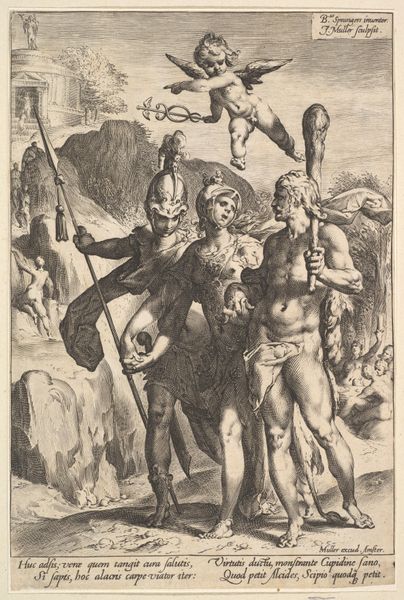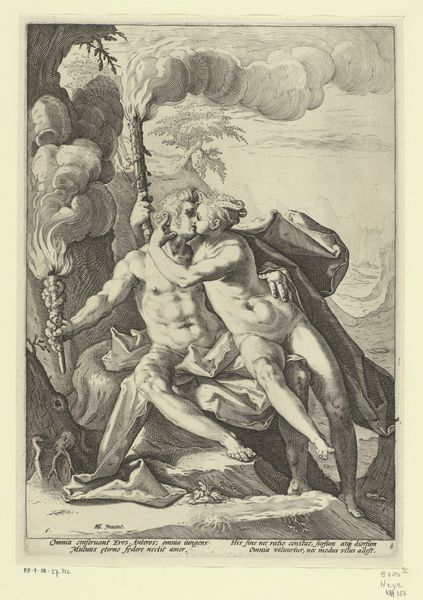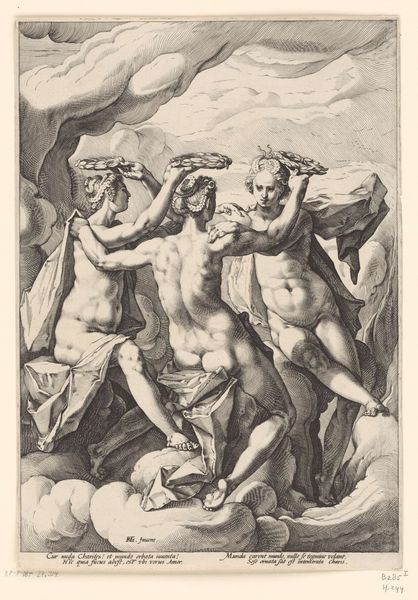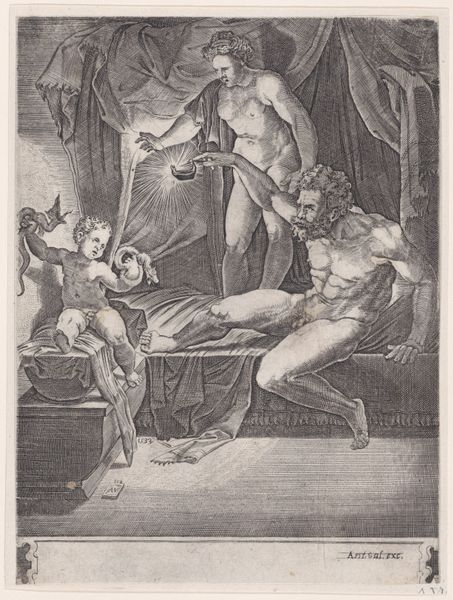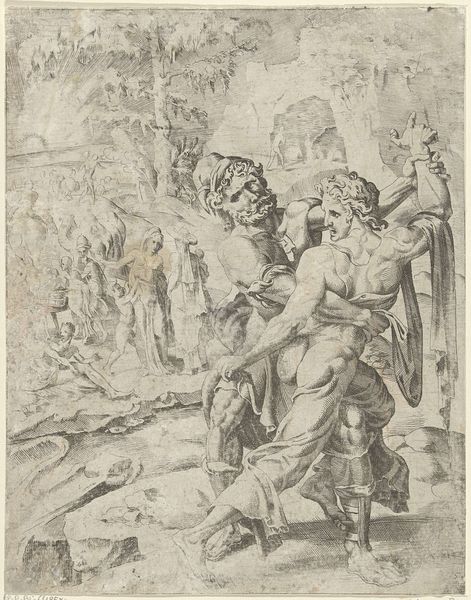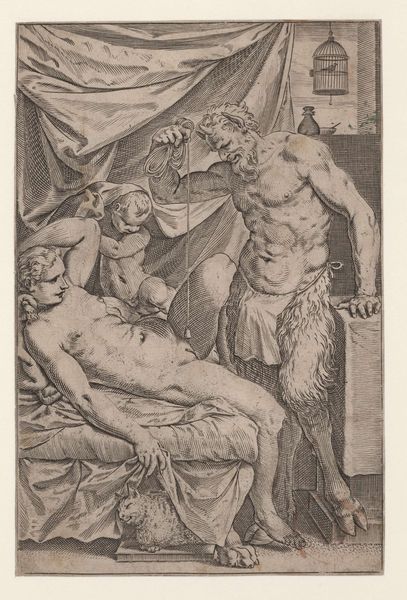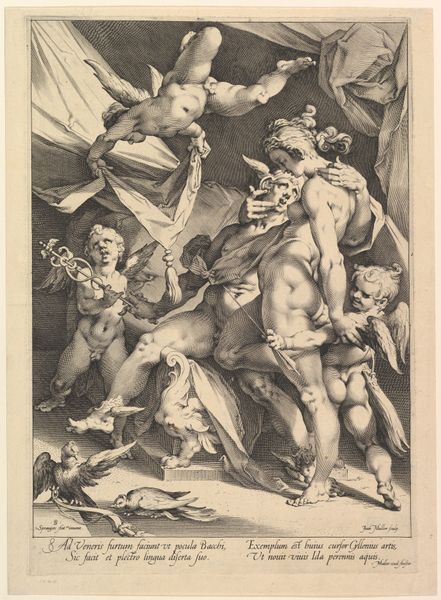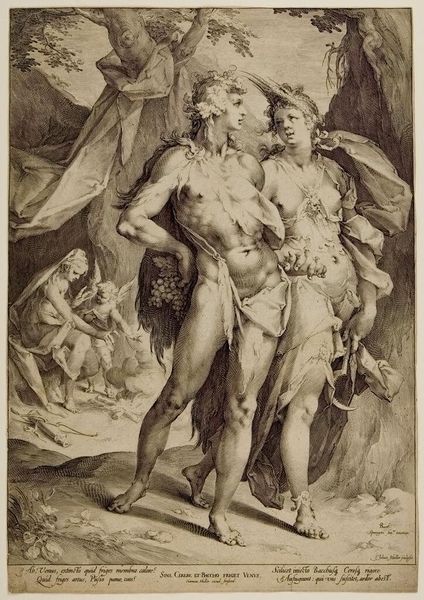![Sine Cerere et Baccho Friget Venus [Without Ceres and Bacchus Venus Grows Cold] by Jan Muller](/_next/image?url=https%3A%2F%2Fd2w8kbdekdi1gv.cloudfront.net%2FeyJidWNrZXQiOiAiYXJ0ZXJhLWltYWdlcy1idWNrZXQiLCAia2V5IjogImFydHdvcmtzLzEzNzYwNmVmLTZiNmItNDQyNy04ZmFiLTM3ZTJhYTc4YTU0MS8xMzc2MDZlZi02YjZiLTQ0MjctOGZhYi0zN2UyYWE3OGE1NDFfZnVsbC5qcGciLCAiZWRpdHMiOiB7InJlc2l6ZSI6IHsid2lkdGgiOiAxOTIwLCAiaGVpZ2h0IjogMTkyMCwgImZpdCI6ICJpbnNpZGUifX19&w=3840&q=75)
Sine Cerere et Baccho Friget Venus [Without Ceres and Bacchus Venus Grows Cold] 1592 - 1602
0:00
0:00
drawing, print, engraving
#
drawing
#
allegory
# print
#
landscape
#
mannerism
#
figuration
#
history-painting
#
engraving
Dimensions: sheet: 20 x 14 1/8 in. (50.8 x 35.8 cm)
Copyright: Public Domain
Curator: This engraving by Jan Muller, dating from somewhere between 1592 and 1602, is entitled "Sine Cerere et Baccho Friget Venus," or "Without Ceres and Bacchus Venus Grows Cold." Editor: It's fascinating. A bit stark, perhaps predictably given the title. I immediately see how the lack of opulence and the grey palette could suggest the absence of warmth and comfort. Curator: Indeed. Muller, who was also a skilled draughtsman, employed an incredibly precise and dense cross-hatching technique in creating this print. Notice how this contributes to the modeling of the figures and their almost sculptural presence? Consider also the vast circulation of prints in the 16th century. Editor: Right. Let's delve into the symbolic meaning. The composition foregrounds Bacchus, the god of wine, and Ceres, the goddess of agriculture and fertility, both rejecting a shivering Venus, goddess of love. This references the old adage, pointing to love’s reliance on food and wine to flourish. Curator: Absolutely. This speaks to the dependence on the material world to support emotional and physical needs. The print becomes not just an artistic piece but a statement on the era's material understanding of pleasure. Look closely at how Muller positions each figure and how their interaction tells us a story about social necessities of sustenance and prosperity. Editor: Also, I'm struck by the skeletal figures on the left and discarded bows and arrows, hinting at the demise that arises without proper care. Muller’s depiction of discarded implements once related to desire further underscores the ephemeral quality without nurture. These icons really pack a visual punch, right? Curator: Precisely. The social critique here goes beyond mere advice; it's a commentary on what sustains relationships. It hints at larger issues of wealth distribution and communal well-being, and how lack impacts basic aspects of human interaction. Editor: It certainly feels timely, considering the questions of dependency we grapple with still. Food and drink may be metaphors here for material support, but ultimately what feeds our emotional connections. Curator: This image certainly reminds us about the tangible circumstances that can shape human experience, not to mention our art production and its ability to reflect these factors across centuries. Editor: Yes, Jan Muller reminds us how cultural memories intertwine in artworks through the language of signs, a language constantly speaking, across time.
Comments
No comments
Be the first to comment and join the conversation on the ultimate creative platform.

